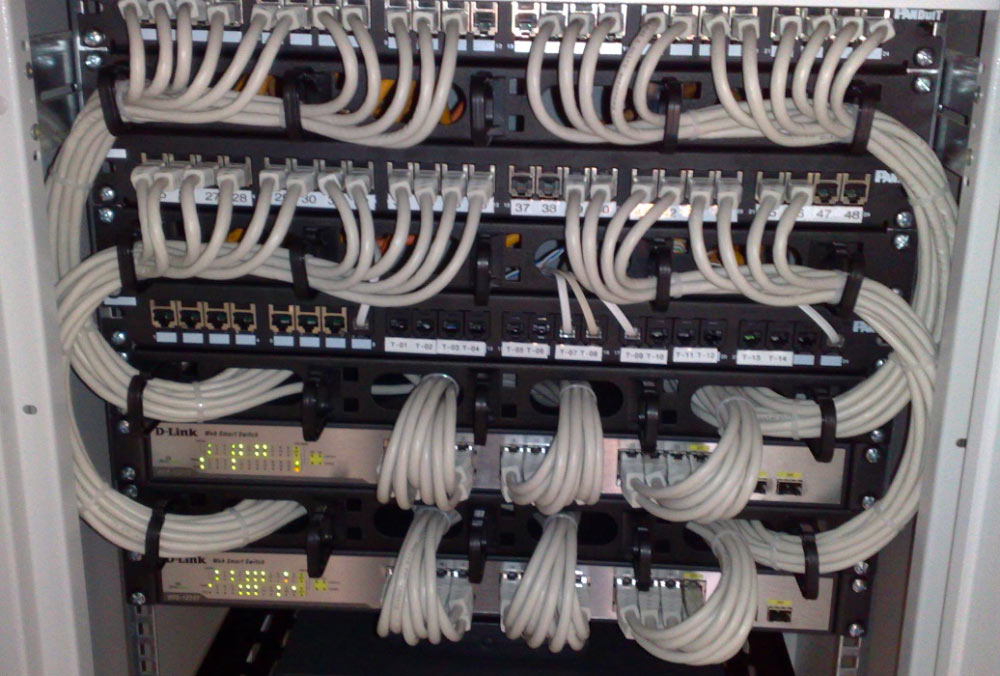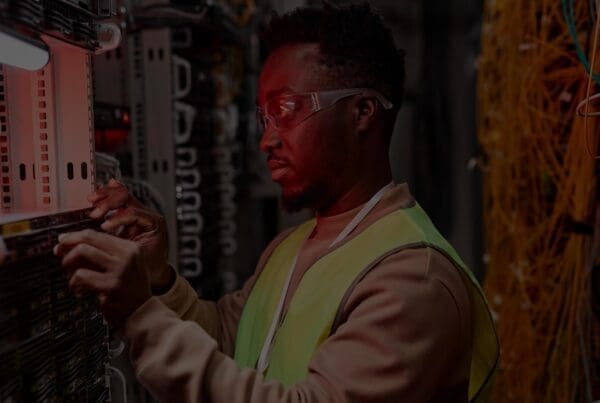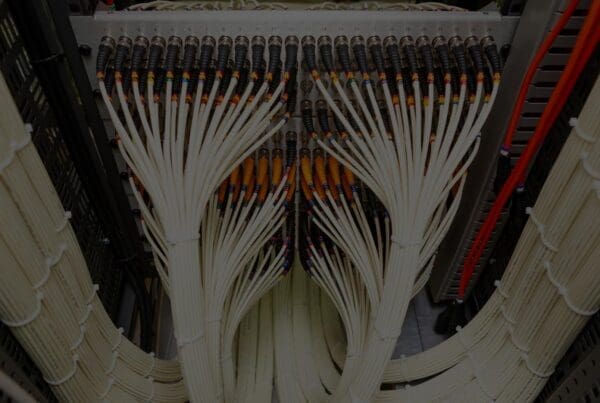In the throes of the digital age, we’ve come to rely heavily on a seamless and efficient flow of data. This modern connectivity, often visualised as wireless symbols and cloud icons, has a physical backbone that plays a crucial role behind the scenes. At the heart of this intricate network lies the IT structured cabling system.
As businesses and homes burgeon with multiple devices, the need for an organised and robust wiring infrastructure becomes paramount.
Enter the structured cabling system, a holistic approach to address complex wiring needs. Designed to cater to the demands of today’s high-speed data flow, it promises not just order but also scalability for the unpredictable future.
What is a Structured Cabling System?
 At its core, a structured cabling system is a comprehensive network of wires, cables, and hardware that facilitate the efficient transfer of data, voice, and multimedia across various networks. It’s the lifeline for modern digital communication, forming a structured approach to cabling infrastructure.
At its core, a structured cabling system is a comprehensive network of wires, cables, and hardware that facilitate the efficient transfer of data, voice, and multimedia across various networks. It’s the lifeline for modern digital communication, forming a structured approach to cabling infrastructure.
Traditional cabling methods relied heavily on point-to-point cabling. This method involved running a cable directly from one point to another. While it might have been suitable for smaller setups, as networks grew, this method quickly became cluttered and chaotic. In contrast, a structured cabling system is all about an organisation. Instead of individual cables running everywhere, this system groups them, paving the way for a more modular and organised approach. The result? Enhanced performance, reduced maintenance hassles, and a cabling infrastructure that’s easier to manage and scale.
Designing a Structured Cabling System: Best Practices
1. Assessment
Before embarking on any structured cabling system project, it’s paramount to assess the business’s current and future needs. This involves understanding the volume of data traffic, the types of devices that will be connected, and anticipating future expansion or scalability requirements. A detailed assessment will not only provide clarity on the immediate needs but also safeguard the infrastructure from becoming obsolete too soon.
2. Blueprint Creation
Once the assessment phase is complete, it’s time to get down to the nitty-gritty of the design. Creating a detailed blueprint is crucial for the success of a structured cabling system. This involves mapping out the routes that cables will take, designating spaces for telecommunications rooms, and determining the locations for all essential components like switches, routers, and patch panels. An effectively mapped-out plan reduces errors during the installation phase and ensures optimal system performance.
3. Redundancy Planning
Any robust structured cabling system should have plans for redundancies. These are backup paths for data flow in case the primary route encounters an issue. By ensuring that there are alternative paths for critical connections, businesses can ensure continuous operations even if one part of the system fails. This proactive approach minimises downtime, prevents potential revenue loss, and maintains the integrity of the structured cabling system even under unforeseen circumstances.
4 Benefits of Structured Cabling Systems
 1. Scalability
1. Scalability
One of the most significant advantages of a structured cabling system is its scalability. As businesses grow and technology advances, there’s an increasing need for infrastructural systems that can adapt. With a structured cabling system, expanding or modifying the existing setup becomes considerably simpler. Whether it’s integrating new technologies or accommodating more users, a structured cabling system is designed with future-proofing in mind.
2. Aesthetic Neatness
Gone are the days when rooms or offices were a jumbled mess of wires and cables. A structured cabling system brings in a sense of order and neatness. Not only does this present a more professional appearance, but it also enhances the workspace’s safety. A clean, clutter-free environment can be especially beneficial in areas where clients or partners might visit, reflecting a sense of organisation and efficiency.
3. Reduced Maintenance Costs
Maintenance and troubleshooting become substantially more straightforward with a structured cabling system. Since everything is organised systematically, pinpointing issues or making changes doesn’t involve sifting through a tangled mess of cables. This not only reduces the time and effort spent on maintenance but also translates to cost savings. A well-maintained structured cabling system also means fewer disruptions and downtimes.
4. Enhanced Data Transmission Speed and Reliability
At the heart of any business operation is the need for fast and reliable data transmission. A structured cabling system, by its very design, ensures that data flows efficiently and with minimal interference or loss. This results in faster data transfer speeds and a more reliable connection, ensuring that businesses can operate seamlessly and effectively in today’s digital age.
3 Common Mistakes and How to Avoid Them
 1. Overlooking Future Needs
1. Overlooking Future Needs
One of the most frequent errors made when setting up a structured cabling system is not taking into account the future growth and evolution of the business. As companies evolve, so do their technological needs. A system that might seem sufficient now could quickly become inadequate if not designed with scalability in mind.
How to Avoid
When planning a structured cabling system, always consider the business’s growth trajectory over the next several years. Factor in potential technological advancements, additional staff, or new departments. Essentially, opt for a structured cabling system that can comfortably accommodate foreseeable changes without requiring a complete overhaul.
2. Not Adhering to Standards
With the immense variety of technological solutions available, some businesses might be tempted to mix and match without strictly adhering to established cabling standards. This can lead to a myriad of problems, from compatibility issues to decreased system performance.
How to Avoid
Stay informed about the latest structured cabling system standards and ensure that all installations and modifications are in compliance. Regularly consulting with industry experts or professionals can help in maintaining adherence to the highest standards, ensuring your structured cabling system remains optimal and effective.
3. Skipping Proper Documentation
A structured cabling system, no matter how well-organised, is of little use if there isn’t comprehensive documentation to match. Not having detailed records can turn troubleshooting or future upgrades into a nightmare, consuming more time and resources.
How to Avoid
From the outset, ensure that every aspect of your structured cabling system is meticulously documented. This includes cable routes, connection points, types of cables used, and any other pertinent information. Regularly update this documentation whenever changes are made to the system. Having a digitalised and well-organised record can save significant time during maintenance or when addressing system issues.
Importance of Choosing Quality Components
 Impact on Performance
Impact on Performance
The cornerstone of any reliable structured cabling system is the quality of its components. Just like the weakest link in a chain, an inferior component can significantly hamper the overall performance of your system. High-quality components ensure faster data transmission, reduced latency, and minimal packet loss. They also minimise the risk of data interference or signal degradation, both of which can compromise the functionality of a network.
Example: Opting for high-quality copper cables in a structured cabling system can lead to better signal strength and faster data transfer rates, ensuring that the network operates smoothly without interruptions.
Longevity and Durability
Investing in premium components for your structured cabling system isn’t just about immediate performance; it’s also about long-term durability. Quality cables and connectors are more resistant to wear and tear, environmental factors, and physical damage. This means fewer replacements, less downtime, and more prolonged optimal performance.
Example: High-quality fibre optic cables, often used in structured cabling systems, are less prone to physical damage and can handle a higher bandwidth, ensuring longevity and consistent performance.
Identifying High-Quality Cabling and Components
It’s vital to know how to discern high-quality components from subpar ones, given the plethora of options in the market.
- Check for Certifications: Reputable manufacturers will often have their products tested and certified by independent bodies. Look for these certifications as they vouch for the component’s quality and compliance with industry standards.
- Read Reviews and Seek Recommendations: The experience of other businesses can guide your choices. Professional reviews, user feedback, and recommendations from trusted sources can point you towards reliable component brands and models for your structured cabling system.
- Physical Examination: If possible, inspect cables for consistent thickness, well-made connectors, and any signs of manufacturing defects. A tangible examination can sometimes reveal more about the component’s quality than any specification sheet.
While it might be tempting to cut corners with cheaper components, remember that the structured cabling system is a long-term investment. Prioritising quality not only ensures optimal performance but also saves costs in the long run due to fewer repairs and replacements.
Conclusion
In today’s digital era, seamless connectivity is paramount. The structured cabling system offers businesses a reliable backbone for modern data exchange, proving itself as not just a wiring solution but a growth tool. Embracing a structured cabling system provides scalability, aesthetic neatness, and efficient data transmission. Proper design and quality components ensure its effectiveness.
To truly harness its benefits, businesses must adhere to best practices and avoid common pitfalls. The structured cabling system is more than just wires; it’s the foundation of modern business operations.
How iCobus Can Help
 iCobus is here to help you find the right talent that understands and appreciates the significance of structured cabling systems. We strive to connect businesses with professionals equipped to handle the challenges and opportunities presented by this essential IT component.
iCobus is here to help you find the right talent that understands and appreciates the significance of structured cabling systems. We strive to connect businesses with professionals equipped to handle the challenges and opportunities presented by this essential IT component.
So, if you’re ready to solidify your structured cabling capabilities, don’t hesitate to get in touch with us. At iCobus, we’re prepared to guide you through your recruitment journey, ensuring you secure the professionals who can navigate your business through the complex world of structured cabling. Let’s embrace the future of IT together.



